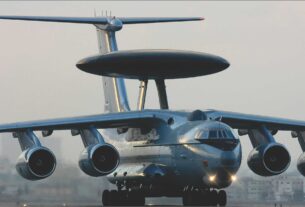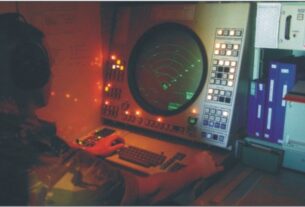In the age of ballistic missiles and supersonic fighters, the deployment of advance air intrusion warning systems have acquired greater relevance. Indian defence establishment is working on a plan to modernize country’s radar network to make its air space impregnable. But this is much behind the schedule.
Though the rival neighboring countries are also making their skies impenetrable for the Indian fighters to prevent them from entering their territory, in Indian defence forces, which made a grand start almost a decade ago with the decision to acquire three AWACAS made with Russian and Israeli collaboration, no additional air borne surveillance systems has yet been made operational.
The Brazilian Embraer based AEW&C is still in the final stages of induction, three of which has been acquired almost six years ago.
Further the deployment of long range and low level surveillance capable advanced radar network has moved at a slow pace and has not been given priority. The concern more is on the depleting fighter strength of Indian Air Force which has gone down at a precarious level.
Slow process
Though the Indian armed forces, in next one decade, are expected to implement US$ 8.5 billion program to deploy modern radar network on its huge land and coastal borders besides the induction of new air borne surveillance systems, its tardy implementation is a cause of worry for its Service headquarters, who have been urging the government to speed up the program, even if it means the import of such systems.
But Indian defence ministry has been focusing more on indigenous development and acquisition program, and probably has met with some significant success, but the neighboring Pakistan with its direct imports from US, Sweden and China has more than matched the capabilities of radar based surveillance of Indian Air Force.
The Indian Air Force has expressed urgent need for ten additional airborne surveillance systems and do not want to depend on indigenous development program as it would take no less than a decade to mature, though the target date has been set for 2020.
Government had last year sanctioned six additional AWACS type surveillance systems to be developed and executed by Center for Airborne Systems of the DRDO, for which the government had issued global expression of interest for six suitable aircrafts on which the surveillance systems would be mounted. The Defence ministry has not taken any further move for selecting a suitable aircraft. According to IAF officials India has a total requirement of around 20 AWACS aircraft, but considering the current pace of decision making and financial resources it seems a remote possibility in the near future.
However, the IAF has expressed doubts over the DRDO’s ability to hand them over six AWACS by the end of this decade, as they feel that the program will be delayed much behind schedule as with earlier development programs. IAF has conveyed to the MoD that they have an urgent requirement for ten AWACS aircraft and waiting indefinitely for the indigenously developed AWACS systems would prove to be harmful for nation’s security. Now the next defence minister will have to face this dilemma of indigenous development or direct imports.
The advantage for Indian armed forces is that Indian defence undertakings have developed sufficient expertise in developing and producing advanced radar systems, but they have always been following the trends in international armed forces. By the time they get operationalized in Indian armed forces, the western companies developing advanced radar systems take not one but many steps ahead and make Indian systems redundant. For example Pakistan Air Force acquired four Swedish SAAB Erieye surveillance systems almost the same year India acquired the first of the three Israeli Phalcon radars based on the Russian Il-76 aircrafts.
The Pakistani Air Force has also been equipped with Chinese ZDK-03 AWACS. This is an advanced Airborne Warning and Control System which has been configured to Pakistan’s requirements and specifications, four of which has been ordered and already in operation with the Pakistan Air Force. This is said to be much more sophisticated aircraft than the SAAB -2000, which is powered by four turboprop engines and has a greater range than SAAB Erieye.
The ZDK-03 has triple tail configuration, one large and two small which provides flight stability after the installation of new radar antenna. Obviously, when the Chinese can equip the Pakistani air force with such sophisticated air borne surveillance systems, one can imagine the air surveillance capability of the Chinese Air Force on the borders with India.
Huge demand
Indian public sector radar developer and manufacturing industries are enthused over the huge projected demand for various radar systems for the Indian armed forces. In fact the competence for developing advanced radars has been allowed to be achieved only by the public sector defence electronics research and development and production companies.
The Electronics and Radar Development Establishment (LRDE) scientists are giving a final shape to the world’s most advanced Active Electronically Scanned Array (AESA) radar to be deployed on the under development Light Combat Aircraft Mk-11 and also the unique “ Through Wall Imaging Radar”. The LCA Mk-11 is expected to be ready by the end of this decade.
Besides the Indian developed Active Array Antenna Unit (AAAU) is being mounted on EMB-1451 surveillance aircraft. The LRDE is also working on a new generation of multi-function radars which can be integrated with any weapon system to provide surveillance, early warning, interception guidance and rapid assessment.
Among them are the medium powered radar called Arudra, which is a low level transportable 150 km range radar and a synthetic aperture radar which is under development. The LRDE had developed the multifunction radar Rajendra, which has been integrated with Surface to Air missile Akash and can be deployed on other surveillance systems also. Also, the DRDO has successfully developed the Central Acquisition Radar which can track over 150 targets simultaneously. The Rohini radar has been developed as derivative for the Air Force and later Revathi for the Navy. For the Indian Army a third derivative called the 3-D Tactical Control Radar is also under production.
Notwithstanding Indian Defence Undertakings ability to produce high end radars, the armed forces are also looking for US, European and Russian companies to supply sophisticated radars for Indian armed forces with much longer range.
However, Indian DRDO has definitely made a significant achievement by reproducing the Israeli Greenpine radars which was acquired a decade ago for the Indian Ballistic Missile Defence program. The DRDO scientists have been able to make an Indian version of the Green Pine radar called the Long Range Tracking Radar. This radar forms the critical component of India’s BMD program and by learning the art of producing the Greenpine radar, they will make the BMD program much more self sufficient and free from foreign electronic interference during the time of conflict.
Raytheon has offered IAF an airborne surveillance and reconnaissance radar which would be suitable for deployment on Indian borders. Raytheon had responded in response to the Request for Information by the Ministry of Defence, but the MoD is yet to make any final move.
In addition to this the Indian Navy has also issued an RFI for 3-D radars for deployment on warships, which can facilitate 360 degree surveillance capability for the detection of aircrafts, helicopters and incoming anti-ship missiles. Radars need urgent and equal attention of the defence bosses, but budgetary support is yet to be seen.




